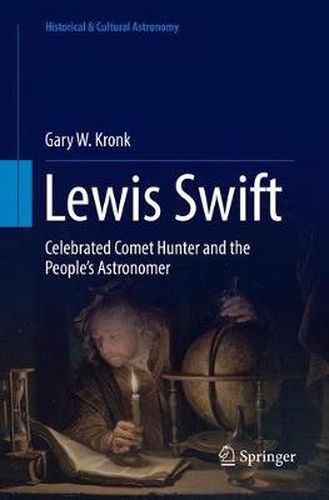Readings Newsletter
Become a Readings Member to make your shopping experience even easier.
Sign in or sign up for free!
You’re not far away from qualifying for FREE standard shipping within Australia
You’ve qualified for FREE standard shipping within Australia
The cart is loading…






This biography covers the life of Lewis Swift (1820-1913), who discovered 13 comets and nearly 1,200 other deep sky objects. All 13 comets found by Swift now bear his name, including three periodic comets with periods of 6 years (11P/Tempel-Swift-LINEAR), 9 years (64P/Swift-Gehrels), and 133 years (109P/Swift-Tuttle). Swift’s enthusiasm and success as an amateur astronomer helped make him famous in the United States. With the help of others, Swift was able to buy a 16-inch refractor, the third largest telescope in the United States at the time. Hulbert Harrington Warner built Warner Observatory to house this telescope. As a prolific writer and lecturer, Swift’s stories appeared in newspapers and magazines, while his lectures showed that he was able to explain anything in a way that everyone could understand.
When Warner went broke during the Panic of 1893, Swift was forced to leave his home. Almost two dozen invitations arrived from around the United States asking him to bring his telescope to their city, and he eventually accepted the invitation of Californian Thaddeus Sobieski Constantin Lowe.
This book highlights Swift’s valuable contributions to astronomy before failing eyesight forced him to give up this profession. In addition to detailing Swift’s life, biographical material is also provided for a number of individuals who were influenced by Swift. This includes his son, Edward, who was discovering deep sky objects as a teenager.
$9.00 standard shipping within Australia
FREE standard shipping within Australia for orders over $100.00
Express & International shipping calculated at checkout
This biography covers the life of Lewis Swift (1820-1913), who discovered 13 comets and nearly 1,200 other deep sky objects. All 13 comets found by Swift now bear his name, including three periodic comets with periods of 6 years (11P/Tempel-Swift-LINEAR), 9 years (64P/Swift-Gehrels), and 133 years (109P/Swift-Tuttle). Swift’s enthusiasm and success as an amateur astronomer helped make him famous in the United States. With the help of others, Swift was able to buy a 16-inch refractor, the third largest telescope in the United States at the time. Hulbert Harrington Warner built Warner Observatory to house this telescope. As a prolific writer and lecturer, Swift’s stories appeared in newspapers and magazines, while his lectures showed that he was able to explain anything in a way that everyone could understand.
When Warner went broke during the Panic of 1893, Swift was forced to leave his home. Almost two dozen invitations arrived from around the United States asking him to bring his telescope to their city, and he eventually accepted the invitation of Californian Thaddeus Sobieski Constantin Lowe.
This book highlights Swift’s valuable contributions to astronomy before failing eyesight forced him to give up this profession. In addition to detailing Swift’s life, biographical material is also provided for a number of individuals who were influenced by Swift. This includes his son, Edward, who was discovering deep sky objects as a teenager.